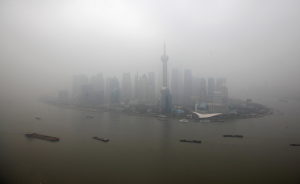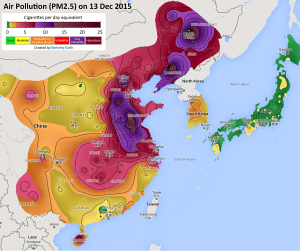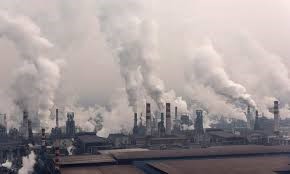
In recent years the world has begun to put China in the headlines regarding their unsettling air pollution levels. Although China was aware of the rising air levels as they were increasing, they only began focusing on enforcing and enacting regulations as a goal when they took the forefront as the nation creating the most carbon emissions.
Increasingly over the last 10 years the world’s nations have become more responsive to the air pollution levels and have become more involved in the efforts to decrease air pollution around the world and at home. China has been a primary focus due to its excessive air pollution and the dangers it could mean for the world.
Since boarders are imaginary lines that are created by nations to define the territory in which they live, boarders themselves do not stop the spread of China’s pollution. With the vast production force and the overwhelming amount of smog the world has to be weary of how these air pollution levels will travel and affect other areas of the world such as Japan and South Korea.
China’s air pollution has been affecting neighboring nations such as Japan and South Korea in recent years. In 2013 Japan and South Korea began to offer assistance to fight China’s air pollution. In the months leading up to this Japan and South Korea became aware that the smog was beginning to seen on the coastlines of their nations and in several instances the nations warned their people to remain indoors due to the unusually high air pollution levels. These outcomes of China’s air pollution are making more people weary of how this could impact the world.

In recent years environmental scientists have begun to analyze the impact that China’s air pollution will have on the world. So far they have collected evidence that the smog is increasing the intensity of the cyclones over the Pacific. The smog has even began to affect the Western coast line of the United States. It has increased the intensity of storms in that area. The pollution is merging into the clouds and increasing the pollution levels in areas near China as well. Slowly, but surely the air pollution being emitted is beginning to impact the world more and more.
China’s air pollution issue has led to a variety of organizations around the world taking part in the matter and attempting to find solutions. Although China is its own nation, the increasing concern of their pollution’s impact on the world is bringing in nations’ attention to assist in protecting the planet. Now, that China is on the world’s stage they are ready to fight their air pollution levels more, but it has not always seemed this way to the people.

“Ten years ago, I asked what that smell in the air was, and I got no answer, now I know. It’s the smell of money.”- Chai Jing, “Under the Dome”
In 2015 this women created a documentary about what life is like living in China. She created this video throughout 2014 and financed it, so that the people of China could know that air pollution is an issue that they are facing. Jing is a prime example of how many people in China live their day to day life. Now, in the year 2016, life is not any better.
For many people that live throughout China day to day life can be quite worrisome, especially if there are children in the house. With the air pollution levels maintaining their high stature and the emissions from factories continuously producing deadly chemicals China’s people have become increasingly skeptical if their air pollution will ever go away.
Since the documentary “Under the Dome” was created it has become apparent that China is not the only nation dealing with astronomical levels of air pollution any more. The Washington Post produced an article explaining that India’s levels of PM 2.5, which is a particulate matter that is linked to lung, eye, nose, and throat irritation, have increased from 2010-2015 while China’s levels decreased by 17 %. Although China’s air pollution levels are beginning to decrease, it is still covered in smog and its people are still being harmed by the poor air quality.
Each year people are affected, harmed, and killed by the smog that covers the cities of China, but not many people are aware of the harmful factor in the air. China has estimated that roughly 1. 6 million people die a year from air pollution related causes. Even though this number is high, there are precautions that have been amended to the air pollution law.
The new additions to the law that were created in 2015 began to limit the amount of emissions being produced in major cities where air pollution has been an ongoing problem. For instance, they have begun limiting private vehicles to only be driven six days out of the week, they have created new gasoline and coal standards, they began to place sensors that measure the amount of Carbon based gasses emitted from cars on major roads, and to make air quality levels, identities of major polluters, and contact information for environmental authorities publicly known. Each of these additions has the power to assist in returning the air pollution levels to normal, yet there are still numerous obstacles in the way to clean air.
Even though this law has been amended with new regulations, there are still many factors creating issues for the enforcement of this policy. In China the government is not liable for enforcing it, so the responsibility is left to the local law enforcers. However, on the local levels the officials are not enforcing the laws to the means that they should be. While the government has acted, the regulations are not being properly enforced.
Some government officials such as Mr. Li, who is the Premier of the State Council in China, attribute the lack of enforcement to being pressured by large corporations. In a sense this is what halted the enforcement of air pollution regulations. However, Mr. Li assured that the government would protect the amended air pollution regulations. In a New York Times article he stated that “All acts of illegal production and emissions will be brought to justice and held accountable.” Even though Mr. Li swears that the Chinese government will do everything in their power to decrease the amount of air pollution, why did they wait till now to begin taking action?
Although the levels of air pollution are beginning to be slowly lowered, the nation is still emitting massive amounts of harmful gasses into the skies. China is not simply polluting the skies, but they also have an environmental infrastructure that is beginning to deteriorate. This degradation threatens to affect the industrial power that China has become.

China became an industrial power during the end of the 20th century when they finally became the new “workshop” of the world. For a decade within this time period China’s GDP grew 10% each year. This led China to an outstanding economy, becoming a world power, and to crippling air pollution. For many years the citizens of China were not aware of the smog forming above them, but over time China’s citizens and the world became aware of China’s deteriorating infrastructure. Without the influence of various nations such as the U.S. and UN many people believe that China would not be showing as much of an interest in their problems regarding air pollution. In many instances combatting air pollution has fallen second to other goals such as maintaining their economic status and nation’s safety. However, since this issue has been put off to the side it has become dangerous to the nation. Now, China is finally acting because the world has turned up the heat on and begun to demand cleaner air from China.
The problem facing the Chinese government is how to maintain the nation’s economy while protecting their people from air pollution. Since the nation was put on the world’s stage they have issued regulations and an alert system, commonly referred to as the Red Alert system. This monitors the amounts of harmful chemicals in the air. When the air quality becomes hazardous that area of the nation issues a red alert warning which closes down factories, schools, and construction zones. This serves to halt the production of chemical emissions, until the air quality is well enough to withstand the emissions produced from a normal day’s routine.
For years China’s people have been living under these conditions, yet the problem is only beginning to be fixed. People can say that this problem came from industrialization, capitalism, globalization, or greed. However, there is no way to pinpoint the specific feature that led to the dire situation China is currently in, but there are people around the world creating ideas to assist in fabricating a better future. For instance, Sanjee Ghotge believes that “China has the opportunity to confront this historical moment and forge ahead of the market economies by adopting a paradigm shift for the future.” He believes they can do so by changing the focus of their production to create objects that can last longer and by shifting their coal driven factories to run on gas. Innovationists such as Ghotge give way for a better future.
However, there are still many critiques involving China’s reasoning for implementing new laws in 2015. Although China is beginning to lower their air pollution levels and is currently finding new solutions to their problem, the looming question yet to be answered is still “Why is the government beginning to focus on regulating air pollution now and why did they not stop the problem before?”
Sources
http://www.tandfonline.com/doi/abs/10.1080/10455752.2015.1105458
Reflection
[1] How well does the title provocatively focus the reader’s attention, as well as the lede? Is it thoughtful, creative, clever? Does it lead the reader into the text and provide some insight into the issue?
The title does not give away what the article about, but it describes a clear focus on China and it makes people wonder why China is important to the world right now and maybe they would read it.
[2] How well does the introductory section of the article invite the reader into the paper, as well as offer up exigency? How does it locate a problem or controversy within a context that provides background and rationale?
The introduction delivers a question as to why it has taken so long for China to respond to their growing air pollution. It is current, because people know that air pollution is harmful and that China is beginning to fix it, but not many people focus on why they did not respond to it earlier. If they had there would be many positive aspects, and the world would not be focusing on China when it comes to pollution. It questions China’s course of actions once the problem is beginning to be addressed and analyzes events that have happened to ask this question.
[3] How well does the writer offer up a strong ‘idea’ that requires analysis to support and evolve it, as well as offers some point about the significance of evidence that would not have been immediately obvious to readers.?
I use the evidence to support my idea and it is not immediately obvious because even though there would have been cons for the economy if China had acted sooner, since China is acting now more countries are focused on this nation and if China had acted sooner than they would not have to worry about every other nation watching them when it comes to production. The reader might not know all of the circumstances surrounding air pollution in China, so they might not be able to make a keen judgement based on the introduction of the argument.
[4] How well does the writer show clarity of thought; uniqueness of presentation; evidence of style; and historicized topics?
In my article I show clarity of though by focusing on sections of the issue at a time such as how the air pollution is impacting the world and other countries, then I transfer this into the topic of life in China. I wrote it this way to give people from other places than China a chance to understand how this is and could potentially affect them. I use quotes and statistics to add more perspective to my argument and demonstrate why the air pollution is an issue or other peoples’ opinions of it.
[5] How well does the writer recognize that a NYTs Magazine audience will challenge ideas that are overgeneralized or underdeveloped or poorly explained? (that is, did the writer avoid cliché and vagueness or address points/issues readers are likely to have?) How well did the writer decide about how to develop, sequence, and organize material?
In my article I tried to avoid the cliché of air pollution endangers the world, because it is something that everyone knows. However, I attempted to analyze the entire situation just to establish the question of why did the nation wait until the air pollution was hazardous. In writing this I am not attempting to blame the nation, but I am putting the question out there.
[6] How well does the writer research a controversy, develop a persuasive stance, utilize research about the topic, and join the ‘debate’ by making an argument of importance?
I use the information to develop a rhetorical appeal or the people in China and to establish why this should be important to the world. I use the information to demonstrate how poor China has become environmentally and to wonder how a nation could let its people live like that.
[7] How well does the writer meet or exceed research expectations of assignment requirements (6 appropriate secondary sources, 1 visual source, (or more) and primary research? ).
I drew overall ideas from many of my sources and I used my primary source which was “Under the Dome” to analyze the lifestyles of people in China. I used the visual sources to demonstrate what the smog actually looks like.
[8] How well does the writer integrate secondary and primary sources (that support and complicate the topic) effectively into the text, introducing and contextualizing them, and “conversing” (i.e. no drop-quoting) in ways that deepen and complicate the analysis?
[9 How well does the writer persuade an audience to consider claims made from a particular position of authority on which you have built your research? How strong and effective is the writer’s use of rhetorical tools (ethos, logos, pathos)?
I think I establish ethos and logos by using other materials to support my argument and I demonstrate pathos by using quotes, visuals, and examples from “Under the Dome” to demonstrate what living in China is like and to demonstrate how it would be if the reader lived there.
[10] How well does the writer select appropriate, interesting, revealing visual? Has the writer placed a visual strategically in the essay and provided relevant commentary on and/or analysis of them? Do the visuals contribute to the essay in meaningful ways (i.e. would the essay be affected if the writer took the visual away)?
I placed an image of the “Under the Dome” picture when I was describing the events from the film in my essay and then when I began speaking of the economy I used the image of all of the factories to when I began explaining the economy and how it assisted in leading China to its air pollution problem.
[11] How well does the writer show development of final article using various drafts, in-class peer editing and workshops, and/or teacher comments?
From the workshop wear we analyzed the main goal of the writer’s argument I changed the basis of my argument. At first my argument represented a cliché and then I adjusted it from that workshop. The scramble workshop did not assist me as much, but from the peer review workshop I began to reorganize my essay and come up with a different and more direct basis for it.
[12] How well does the writer use hyperlinks—are they effective/appropriate?
I did not add hyperlinks to my article, so they are ineffective.
[13] How well did the writer edit for grammar, style, and usage effectively? Does the writer’s attention to sentence level issues help him/her establish authority or credibility on the issue?
I read through my article a number of times, so I think that I caught any mistakes in grammar and editing. I think my style of examining the different aspects surrounding the issue help me to provide a different perspective on this issue.

